An Adaptive Model-Based MPPT Technique with Drift-Avoidance for Grid-Connected PV Systems
Abstract
:1. Introduction
2. PV System Modeling
2.1. PV Source Investigation and Modeling
2.2. Two-Level Inverter Structure with the Grid
3. MPPT Techniques and Drift Problem
3.1. Drift Analysis
3.2. The Traditional P&O Algorithm
3.3. The Proposed Adaptive Model-Based MPPT Technique
4. Dead-Beat Predictive Control for the Two-Level Inverter
5. Simulation Results and Discussions
5.1. Performance Investigation of the Grid-Connected PV System with Radiation Variation
5.2. Performance of the Grid-Connected PV System with Temperature Variation
5.3. Performance of the Grid-Connected PV System with Parameter Mismatches
6. Future Scope
- Other curve fitting tools can be utilized for accurate MPP location identification. Moreover, the data-sheet parameters as used in the proposed algorithm and experimental characteristics should be accounted for to mitigate expected deviations when working at real PV and harsh atmospheric sites.
- Investigation of the PV source parameters’ variations in the developed MPPT. The parameters of the PV source are exposed to variations due to aging and atmospheric condition changes. Thus, the MPPT should consider that issue and make sure to use factors that are most likely slow varying, while avoiding models or factors that may deteriorate the MPPT efficiency. For example, neglecting the temperature effect in the model-based MPPT techniques may lead to the operation at open circuit condition.
- Recently, monitoring of the PV source is very important to supervise online the performance of the PV system, and to expect potential faults; and to estimate the PV parameters of the PV source for the purpose of fault diagnosis. Thus, the calibration of the model-based MPPT technique can be included in the monitoring stage for MPPT enhancement and ease of operation.
- Sensorless operation—in the proposed study, the radiation is estimated using the already existing current and voltage sensors. This indeed increases the system’s reliability with cost reduction. However, a more powerful estimator can be implemented for efficiency improvement. Meta-heuristic algorithms can be combined for radiation or temperature estimation. However, the calculation burden should be taken into consideration for practical implementation. Moreover, long-term prediction techniques for atmospheric conditions can simplify the sensorless operation.
- Partial shading’s effects should be investigated on the system’s performance, as could modifying the algorithm to track the global peak to maximize the harnessed PV power.
7. Conclusions
Author Contributions
Funding
Acknowledgments
Conflicts of Interest
References
- Pudukudy, M.; Yaakob, Z.; Mohammad, M.; Narayanan, B.; Sopian, K. Renewable hydrogen economy in Asia—Opportunities and challenges: An overview. Renew. Sustain. Energy Rev. 2014, 30, 743–757. [Google Scholar] [CrossRef]
- Owusu, P.A.; Samuel, A.-S. A review of renewable energy sources, sustainability issues and climate change mitigation. Cogent Eng. 2016, 3, 1167990. [Google Scholar] [CrossRef]
- Ahmed, M.; Mohamed, A.; Ralph, K.; Christoph, M.H. Maximum Power Point Tracking Based Model Predictive Control and Extended Kalman Filter Using Single Voltage Sensor for PV Systems. In Proceedings of the 2020 IEEE 29th International Symposium on Industrial Electronics (ISIE), Delft, The Netherlands, 17–19 June 2020; pp. 1039–1044. [Google Scholar]
- Zahedi, A. Maximizing solar PV energy penetration using energy storage technology. Renew. Sustain. Energy Rev. 2011, 15, 866–870. [Google Scholar] [CrossRef]
- Al-Masri, H.M.; Abu-Errub, A.; Walaa, R.A.; Mark, E. On the PV module characteristics. In Proceedings of the 2016 International Symposium on Power Electronics, Electrical Drives, Automation and Motion (SPEEDAM), Capri, Italy, 22–24 June 2016; pp. 901–905. [Google Scholar]
- Bilgili, M.; Arif, O.; Besir, S.; Ali, K. An overview of renewable electric power capacity and progress in new technologies in the world. Renew. Sustain. Energy Rev. 2015, 49, 323–334. [Google Scholar] [CrossRef]
- Taibi, E.; Dolf, G.; Morgan, B. The potential for renewable energy in industrial applications. Renew. Sustain. Energy Rev. 2012, 16, 735–744. [Google Scholar] [CrossRef]
- Hosseini, S.E.; Mazlan, A.W. Hydrogen production from renewable and sustainable energy resources: Promising green energy carrier for clean development. Renew. Sustain. Energy Rev. 2016, 57, 850–866. [Google Scholar] [CrossRef]
- Gao, F.; Ding, L.; Poh, C.L.; Yi, T.; Peng, W. Indirect dc-link voltage control of two-stage single-phase PV inverter. In Proceedings of the 2009 IEEE energy conversion congress and exposition, San Jose, CA, USA, 20–24 September 2009; pp. 1166–1172. [Google Scholar]
- Ayad, A.; Ralph, K. A comparison of quasi-Z-source inverters and conventional two-stage inverters for PV applications. EPE J. 2017, 27, 43–59. [Google Scholar] [CrossRef]
- Li, H.; Xu, Y.; Adhikari, S.; Rizy, D.T.; Li, F.; Irminger, P. Real and reactive power control of a three-phase single-stage PV system and PV voltage stability. In Proceedings of the 2012 IEEE Power and Energy Society General Meeting, San Diego, CA, USA, 22–26 July 2012; pp. 1–8. [Google Scholar]
- Ahmed, M.; Mohamed, A.; Ralph, K. Highly Efficient and Robust Grid Connected Photovoltaic System Based Model Predictive Control with Kalman Filtering Capability. Sustainability 2020, 12, 4542. [Google Scholar] [CrossRef]
- Bhatnagar, P.; Nema, R.K. Maximum power point tracking control techniques: State-of-the-art in photovoltaic applications. Renew. Sustain. Energy Rev. 2013, 23, 224–241. [Google Scholar] [CrossRef]
- De Brito, M.A.G.; Galotto, L.; Sampaio, L.P.; Melo, G.D.A.; Canesin, C.A. Evaluation of the main MPPT techniques for photovoltaic applications. IEEE Trans. Ind. Electron. 2012, 60, 1156–1167. [Google Scholar] [CrossRef]
- Verma, D.; Nema, S.; Shilya, A.M.; Dash, S.K. Maximum power point tracking (MPPT) techniques: Recapitulation in solar photovoltaic systems. Renew. Sustain. Energy Rev. 2016, 54, 1018–1034. [Google Scholar] [CrossRef]
- Sera, D.; Mathe, L.; Kerekes, T.; Spataru, S.V.; Teodorescu, R. On the perturb-and-observe and incremental conductance MPPT methods for PV systems. IEEE J. Photovolt. 2013, 3, 1070–1078. [Google Scholar] [CrossRef]
- Ahmed, M.; Abdelrahem, M.; Kennel, R.; Hackl, C.M. A robust maximum power point tracking based model predictive control and extended Kalman filter for PV systems. In Proceedings of the 2020 International Symposium on Power Electronics, Electrical Drives, Automation and Motion (SPEEDAM), Sorrento, Italy, 24–26 June 2020; pp. 514–519. [Google Scholar]
- Lashab, A.; Dezso, S.; Josep, M.G.; Lászlo, M.; Aissa, B. Discrete model-predictive-control-based maximum power point tracking for PV systems: Overview and evaluation. IEEE Trans. Power Electron. 2017, 33, 7273–7287. [Google Scholar] [CrossRef]
- Femia, N.; Petrone, G.; Spagnuolo, G.; Vitelli, M. Optimization of perturb and observe maximum power point tracking method. IEEE Trans. Power Electron. 2005, 20, 963–973. [Google Scholar] [CrossRef]
- Mei, Q.; Shan, M.; Liu, L.; Guerrero, J.M. A novel improved variable step-size incremental-resistance MPPT method for PV systems. IEEE Trans. Ind. Electron. 2010, 58, 2427–2434. [Google Scholar] [CrossRef]
- Abdelsalam, A.K.; Ahmed, M.M.; Shehab, A.; Prasad, N.E. High-performance adaptive perturb and observe MPPT technique for photovoltaic-based microgrids. IEEE Trans. Power Electron. 2011, 26, 1010–1021. [Google Scholar] [CrossRef]
- Ahmed, J.; Zainal, S. A modified P&O maximum power point tracking method with reduced steady-state oscillation and improved tracking efficiency. IEEE Trans. Sustain. Energy 2016, 7, 1506–1515. [Google Scholar]
- Killi, M.; Susovon, S. Modified perturb and observe MPPT algorithm for drift avoidance in photovoltaic systems. IEEE Trans. Ind. Electron. 2015, 62, 5549–5559. [Google Scholar] [CrossRef]
- Li, X.; Huiqing, W.; Yihua, H.; Lin, J. Drift-free current sensorless MPPT algorithm in photovoltaic systems. Solar Energy 2019, 177, 118–126. [Google Scholar] [CrossRef]
- Zeb, K.; Uddin, W.; Khan, M.A.; Ali, Z.; Ali, M.U.; Christofides, N.; Kim, H.J. A comprehensive review on inverter topologies and control strategies for grid connected photovoltaic system. Renew. Sustain. Energy Rev. 2018, 94, 1120–1141. [Google Scholar] [CrossRef]
- Hassaine, L.; Lias, E.O.; Quintero, J.; Salas, V. Overview of power inverter topologies and control structures for grid connected photovoltaic systems. Renew. Sustain. Energy Rev. 2014, 30, 796–807. [Google Scholar] [CrossRef]
- Blaabjerg, F.; Remus, T.; Marco, L.; Adrian, V.T. Overview of control and grid synchronization for distributed power generation systems. IEEE Trans. Ind. Electron. 2006, 53, 1398–1409. [Google Scholar] [CrossRef] [Green Version]
- Bouafia, A.; Jean-Paul, G.; Fateh, K. Predictive direct power control of three-phase pulsewidth modulation (PWM) rectifier using space-vector modulation (SVM). IEEE Trans. Power Electron. 2009, 25, 228–236. [Google Scholar] [CrossRef]
- Kadri, R.; Jean-Paul, G.; Gerard, C. An improved maximum power point tracking for photovoltaic grid-connected inverter based on voltage-oriented control. IEEE Trans. Ind. Electron. 2010, 58, 66–75. [Google Scholar] [CrossRef]
- Yang, H.; Zhang, Y.; Liang, J.; Liu, J.; Zhang, N.; Walker, P.D. Robust deadbeat predictive power control with a discrete-time disturbance observer for PWM rectifiers under unbalanced grid conditions. IEEE Trans. Power Electron. 2018, 34, 287–300. [Google Scholar] [CrossRef] [Green Version]
- Noguchi, T.; Hiroaki, T.; Seiji, K.; Isao, T. Direct power control of PWM converter without power-source voltage sensors. IEEE Trans. Ind. Appl. 1998, 34, 473–479. [Google Scholar] [CrossRef]
- Zhang, Y.; Li, Z.; Zhang, Y.; Xie, W.; Piao, Z.; Hu, C. Performance improvement of direct power control of PWM rectifier with simple calculation. IEEE Trans. Power Electron. 2012, 28, 3428–3437. [Google Scholar] [CrossRef]
- Rodriguez, J.; Kazmierkowski, M.P.; Espinoza, J.R.; Zanchetta, P.; Abu-Rub, H.; Young, H.A.; Rojas, C.A. State of the art of finite control set model predictive control in power electronics. IEEE Trans. Ind. Inform. 2012, 9, 1003–1016. [Google Scholar] [CrossRef]
- Cortes, P.; Rodriguez, J.; Silva, C.; Flores, A. Delay compensation in model predictive current control of a three-phase inverter. IEEE Trans. Ind. Electron. 2011, 59, 1323–1325. [Google Scholar] [CrossRef]
- Harbi, I.; Mohamed, A.; Mostafa, A.; Ralph, K. Reduced-Complexity Model Predictive Control with Online Parameter Assessment for a Grid-Connected Single-Phase Multilevel Inverter. Sustainability 2020, 12, 7997. [Google Scholar] [CrossRef]
- Vazquez, S.; Leon, J.I.; Franquelo, L.G.; Carrasco, J.M.; Martinez, O.; Rodriguez, J.; Cortes, P.; Kouro, S. Model predictive control with constant switching frequency using a discrete space vector modulation with virtual state vectors. In Proceedings of the 2009 IEEE International Conference on Industrial Technology, Churchill, Victoria, Australia, 10–13 February 2009; pp. 1–6. [Google Scholar]
- Sebaaly, F.; Hani, V.; Hadi, Y.K.; Kamal, A.-H. Novel current controller based on MPC with fixed switching frequency operation for a grid-tied inverter. IEEE Trans. Ind. Electron. 2017, 65, 6198–6205. [Google Scholar] [CrossRef]
- Ahmed, J.; Zainal, S. An improved perturb and observe (P&O) maximum power point tracking (MPPT) algorithm for higher efficiency. Appl. Energy 2015, 150, 97–108. [Google Scholar]
- Lashab, A.; Dezso, S.; Josep, M.G. A dual-discrete model predictive control-based MPPT for PV systems. IEEE Trans. Power Electron. 2019, 34, 9686–9697. [Google Scholar] [CrossRef]
- Abouadane, H.; Fakkar, A.; Sera, D.; Lashab, A.; Spataru, S.; Kerekes, T. Multiple-Power-Sample Based P&O MPPT for Fast-Changing Irradiance Conditions for a Simple Implementation. IEEE J. Photovolt. 2020, 10, 1481–1488. [Google Scholar]
- Dirscherl, C.; Christoph, H.; Korbinian, S. Modellierung und Regelung von modernen Windkraftanlagen: Eine Einführung. In Elektrische Antriebe-Regelung von Antriebssystemen; Springer: Berlin/Heidelberg, Germany, 2015; pp. 1540–1614. [Google Scholar]
- Elgendy, M.A.; Bashar, Z.; David, J.A. Assessment of perturb and observe MPPT algorithm implementation techniques for PV pumping applications. IEEE Trans. Sustain. Energy 2011, 3, 21–33. [Google Scholar] [CrossRef]
- Safari, A.; Saad, M. Simulation and hardware implementation of incremental conductance MPPT with direct control method using cuk converter. IEEE Trans. Ind. Electron. 2010, 58, 1154–1161. [Google Scholar] [CrossRef]
- Li, X.; Huiqing, W.; Lin, J.; Weidong, X.; Yang, D.; Chenhao, Z. An improved MPPT method for PV system with fast-converging speed and zero oscillation. IEEE Trans. Ind. Appl. 2016, 52, 5051–5064. [Google Scholar] [CrossRef]
- Islam, H.; Mekhilef, S.; Shah, N.B.M.; Soon, T.K.; Seyedmahmousian, M.; Horan, B.; Stojcevski, A. Performance evaluation of maximum power point tracking approaches and photovoltaic systems. Energies 2018, 11, 365. [Google Scholar] [CrossRef] [Green Version]
- Elgendy, M.A.; Zahawi, B.; Atkinson, D.J. Comparison of directly connected and constant voltage controlled photovoltaic pumping systems. IEEE Trans. Sustain. Energy 2010, 1, 184–192. [Google Scholar] [CrossRef]
- Liu, Y.H.; Liu, C.L.; Huang, J.W.; Chen, J.H. Neural-network-based maximum power point tracking methods for photovoltaic systems operating under fast changing environments. Sol. Energy 2013, 89, 42–53. [Google Scholar] [CrossRef]
- Ai, B.; Yang, H.; Shen, H.; Liao, X. Computer-aided design of PV/wind hybrid system. Renew. Energy 2003, 28, 1491–1512. [Google Scholar] [CrossRef]
- Abdel-Salam, M.; El-Moh, M.T.; El-Ghazaly, M. An Efficient Tracking of MPP in PV Systems Using a Newly-Formulated P&O-MPPT Method Under Varying Irradiation Levels. J. Electr. Eng. Technol. 2020, 15, 501–513. [Google Scholar]
- Yilmaz, U.; Omer, T.; Ahmet, T. Improved MPPT method to increase accuracy and speed in photovoltaic systems under variable atmospheric conditions. Int. J. Electr. Power Energy Syst. 2019, 113, 634–651. [Google Scholar] [CrossRef]
- Coelho, R.F.; Filipe, M.C.; Denizar, C.M. A MPPT approach based on temperature measurements applied in PV systems. In Proceedings of the 2010 IEEE International Conference on Sustainable Energy Technologies (ICSET), Kandy, Sri Lanka, 6–9 December 2010; pp. 1–6. [Google Scholar]
- Vicente, E.M.; Moreno, R.L.; Ribeiro, E.R. MPPT technique based on current and temperature measurements. Int. J. Photoenergy 2015, 2015, 242745. [Google Scholar] [CrossRef]
- Chikh, A.; Ambrish, C. An optimal maximum power point tracking algorithm for PV systems with climatic parameters estimation. IEEE Trans. Sustain. Energy 2015, 6, 644–652. [Google Scholar] [CrossRef]
- Moshksar, E.; Teymoor, G. Real-time estimation of solar irradiance and module temperature from maximum power point condition. IET Sci. Meas. Technol. 2018, 12, 807–815. [Google Scholar] [CrossRef]
- Ishaque, K.; Zainal, S.; George, L. The performance of perturb and observe and incremental conductance maximum power point tracking method under dynamic weather conditions. Appl. Energy 2014, 119, 228–236. [Google Scholar] [CrossRef]
- Langella, R.; Alfredo, T.; Et, A. IEEE Recommended Practice and Requirements for Harmonic Control in Electric Power Systems; IEEE: Piscataway Township, NJ, USA, 2014. [Google Scholar]
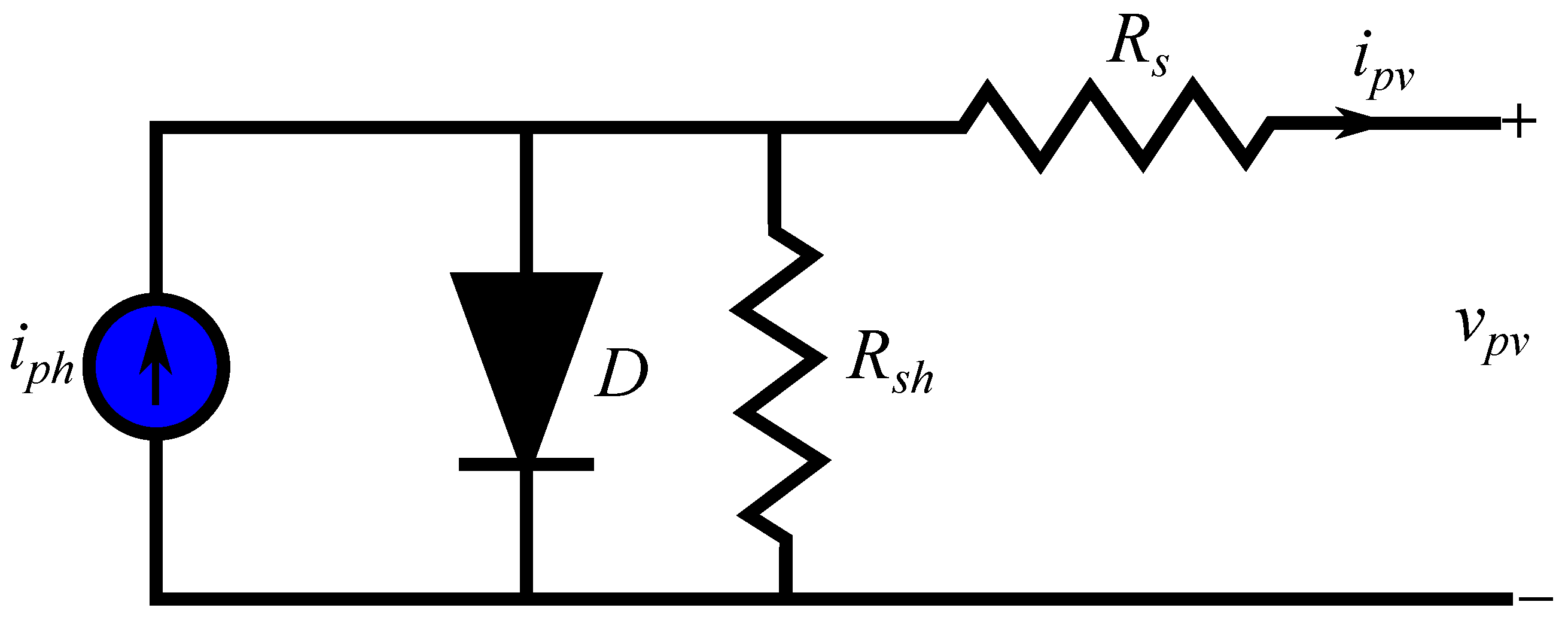
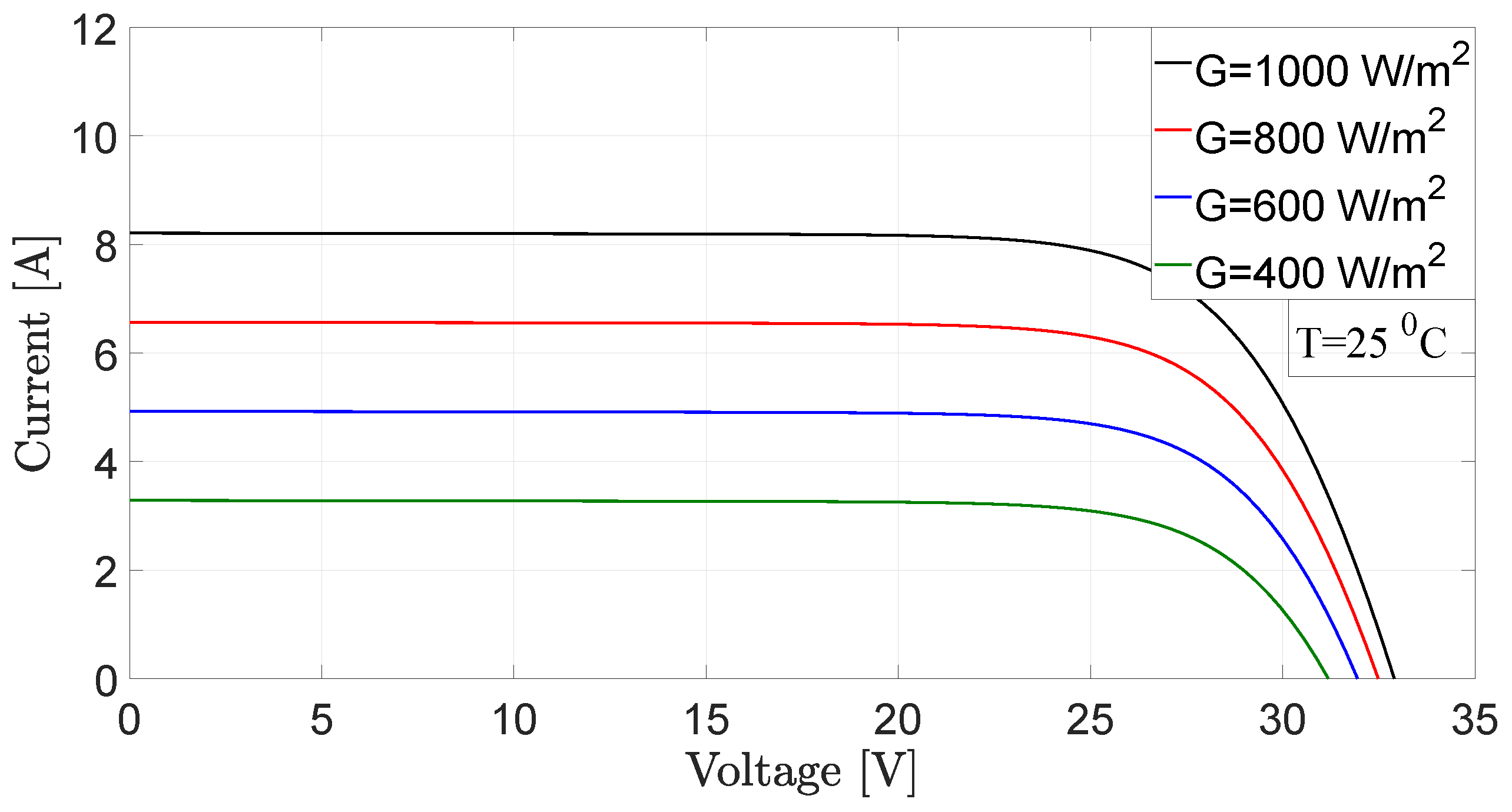
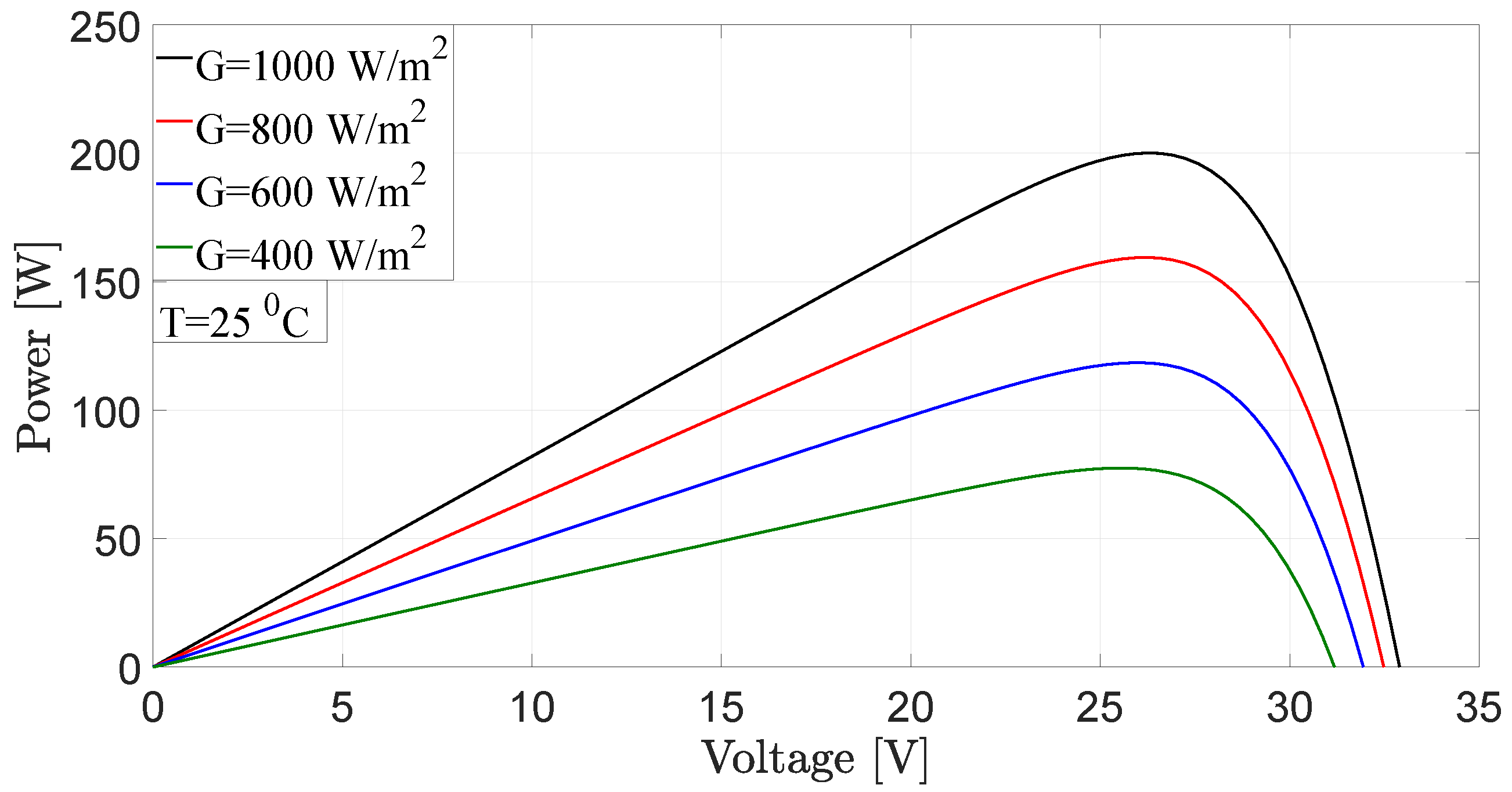
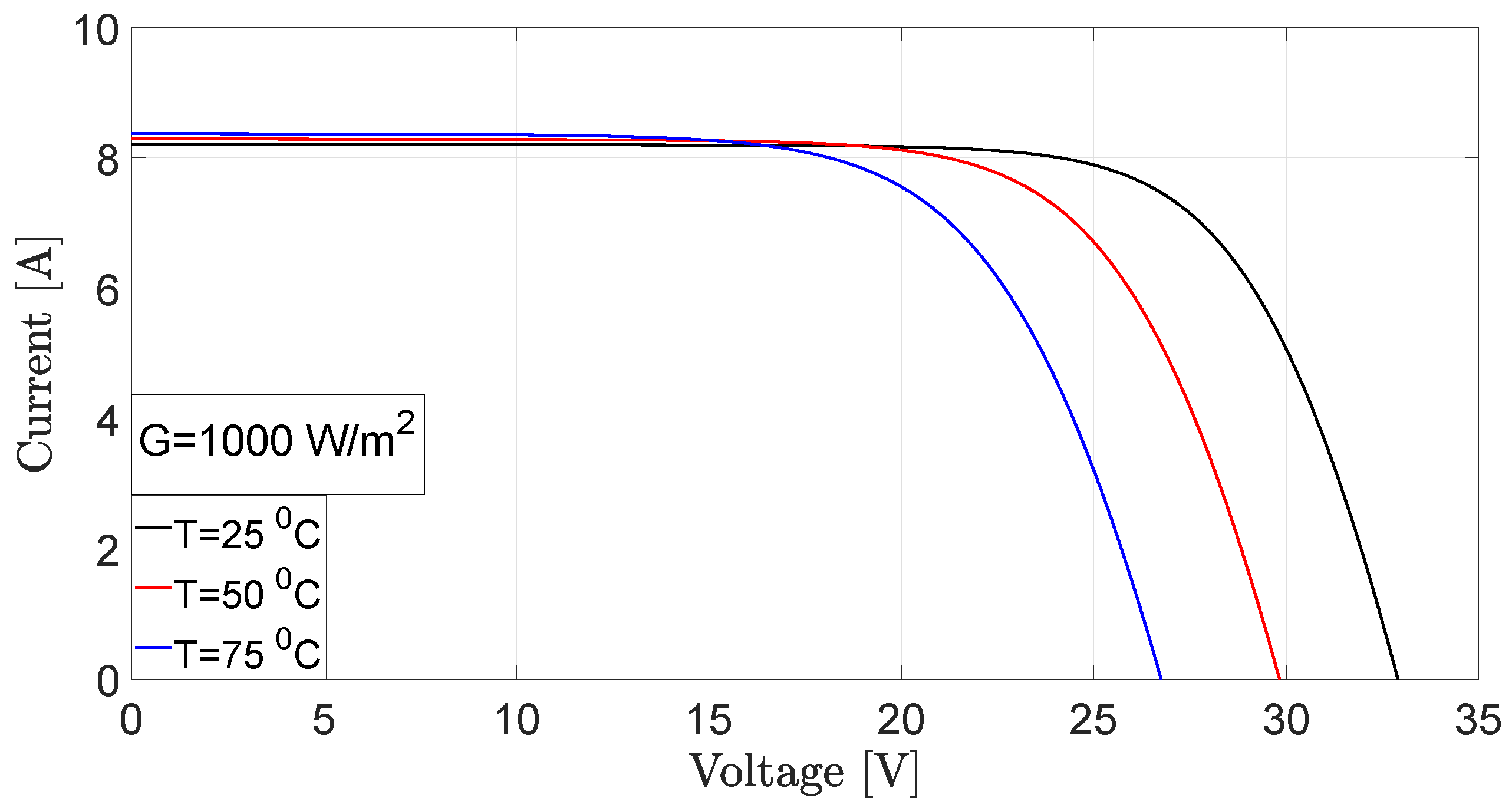
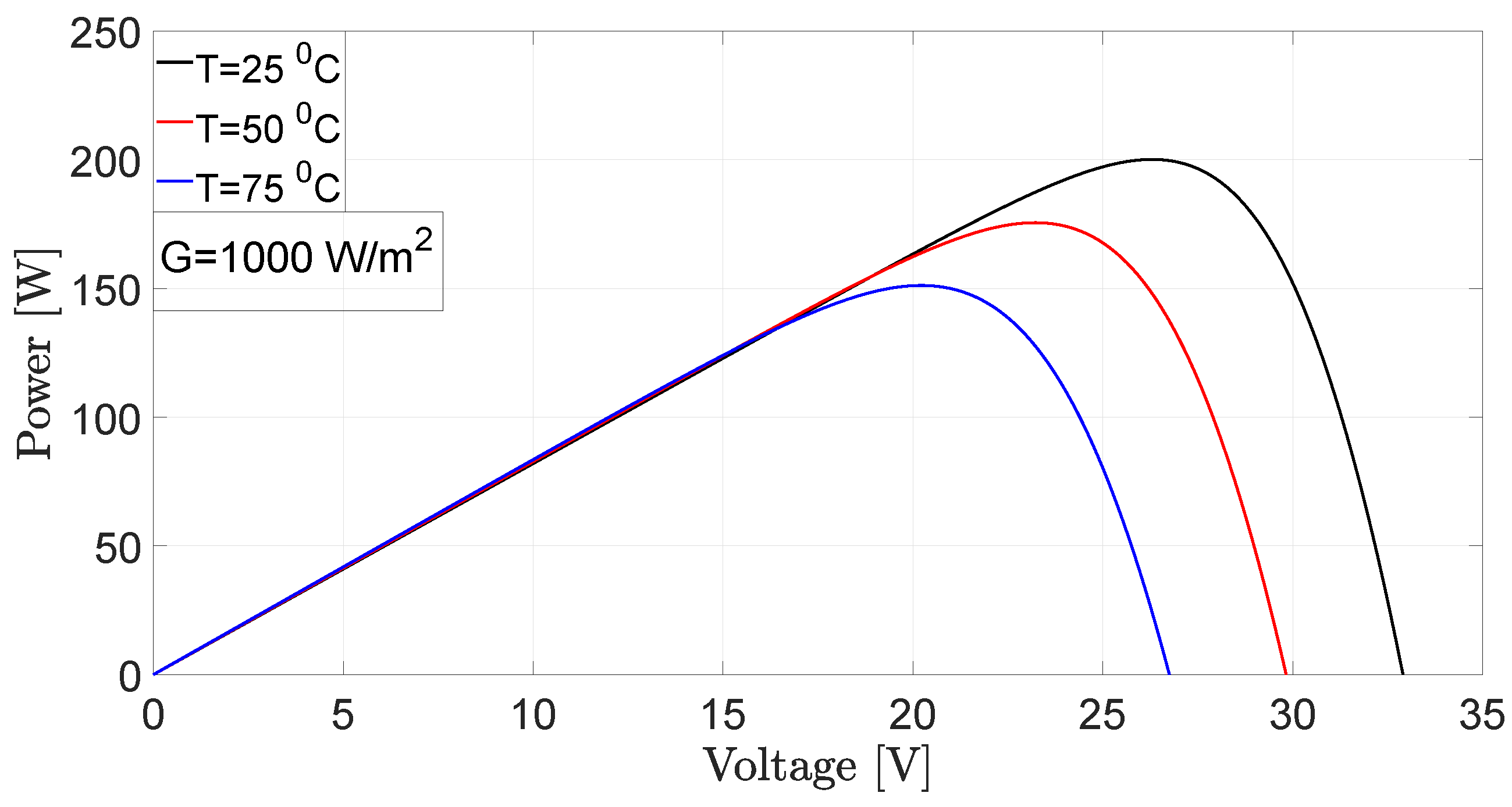
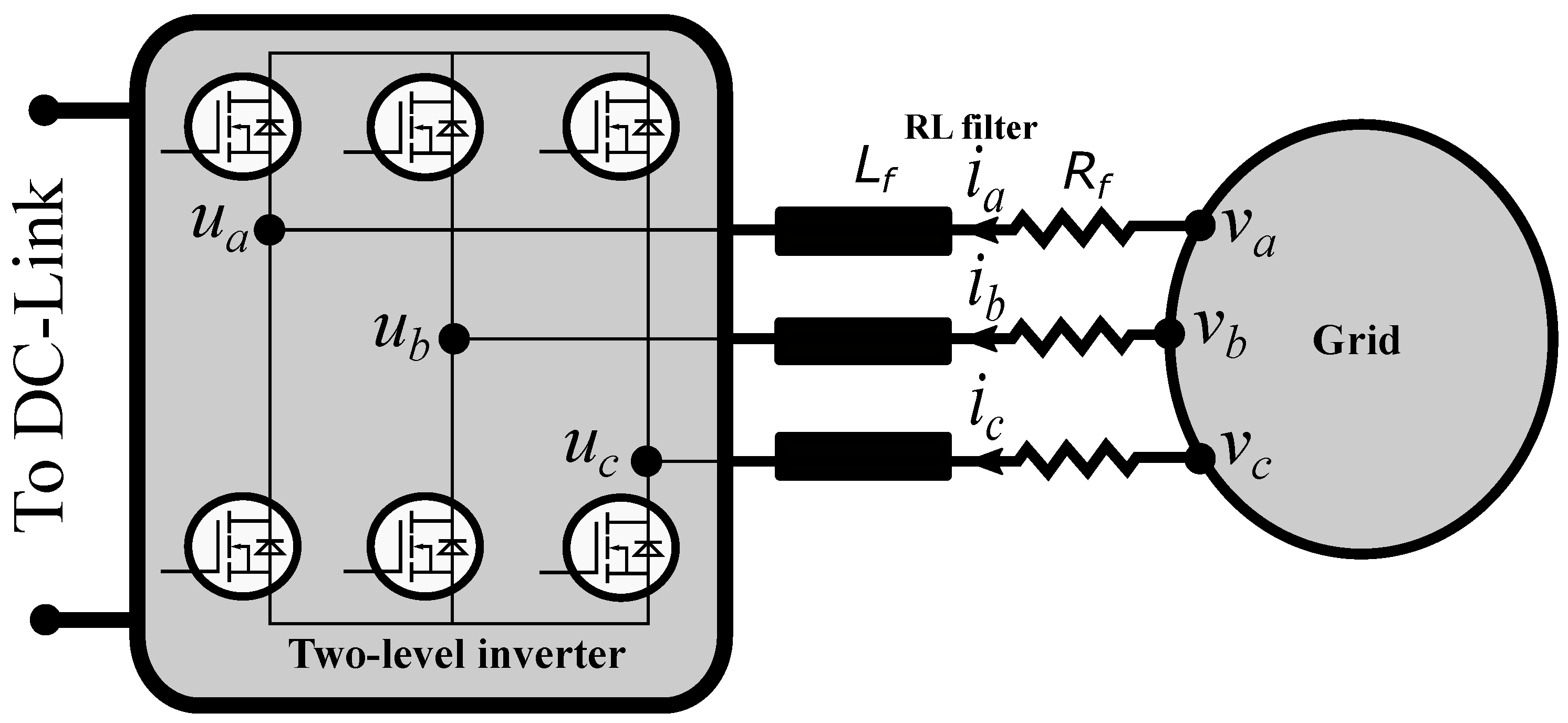


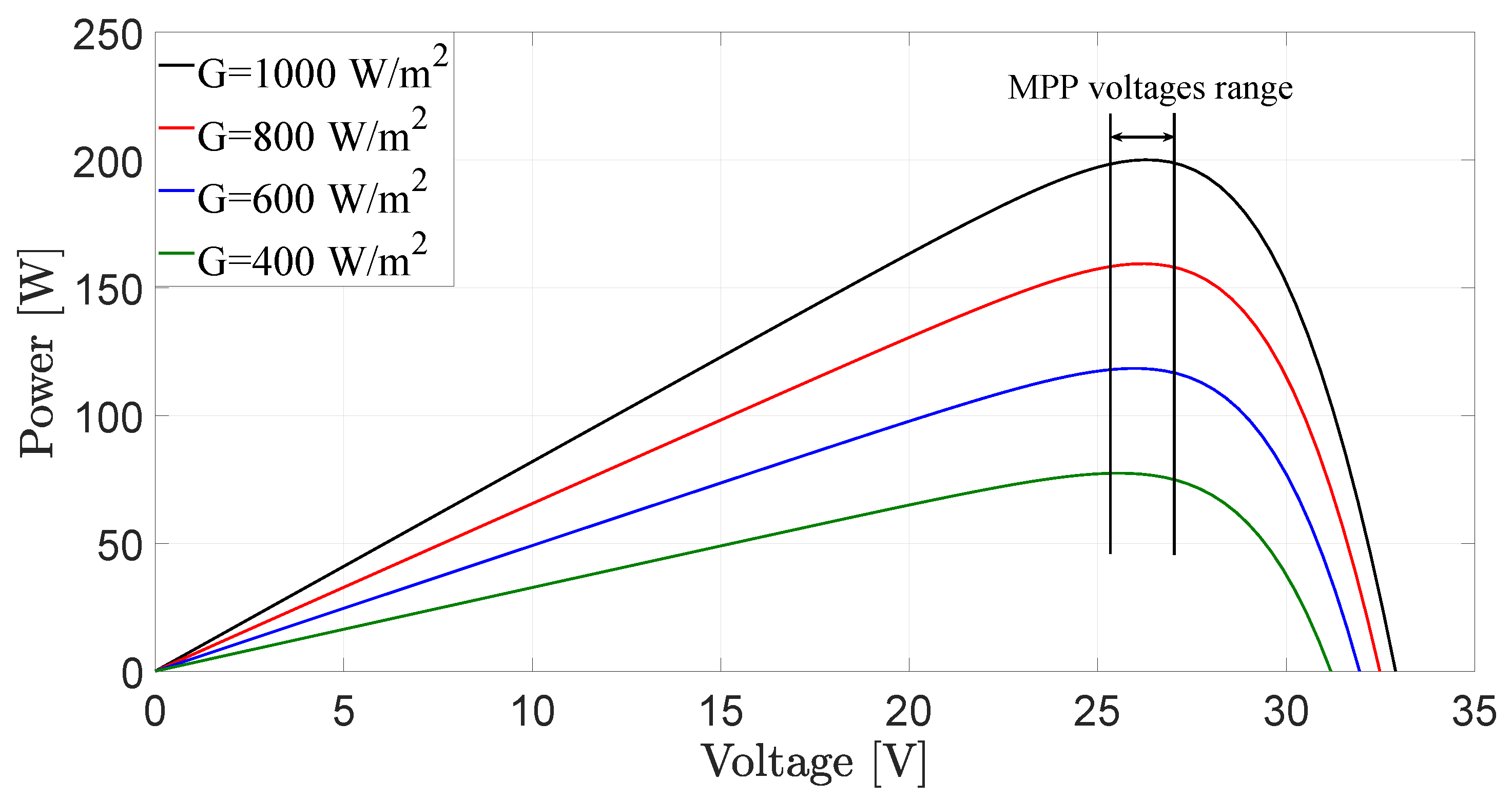

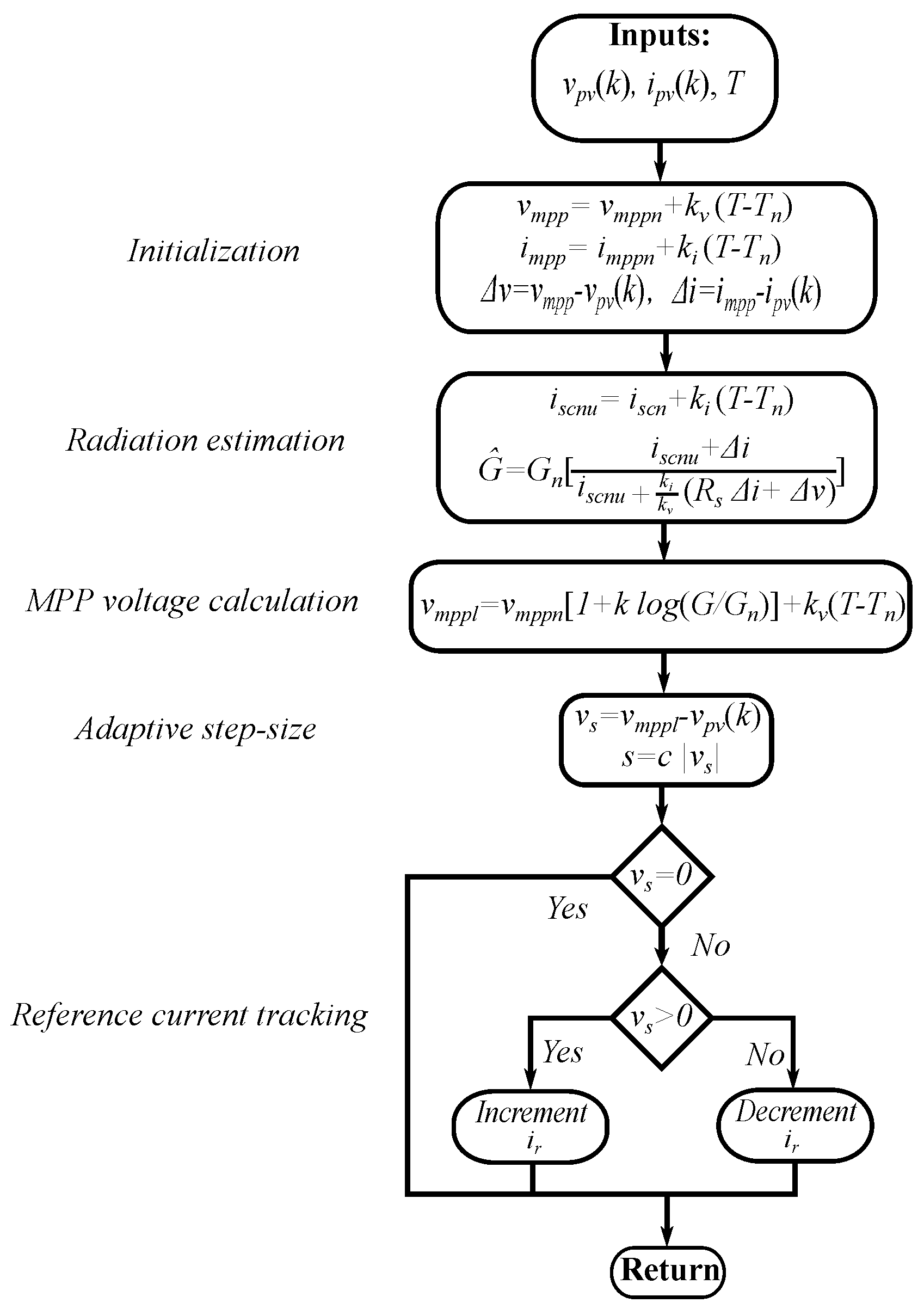
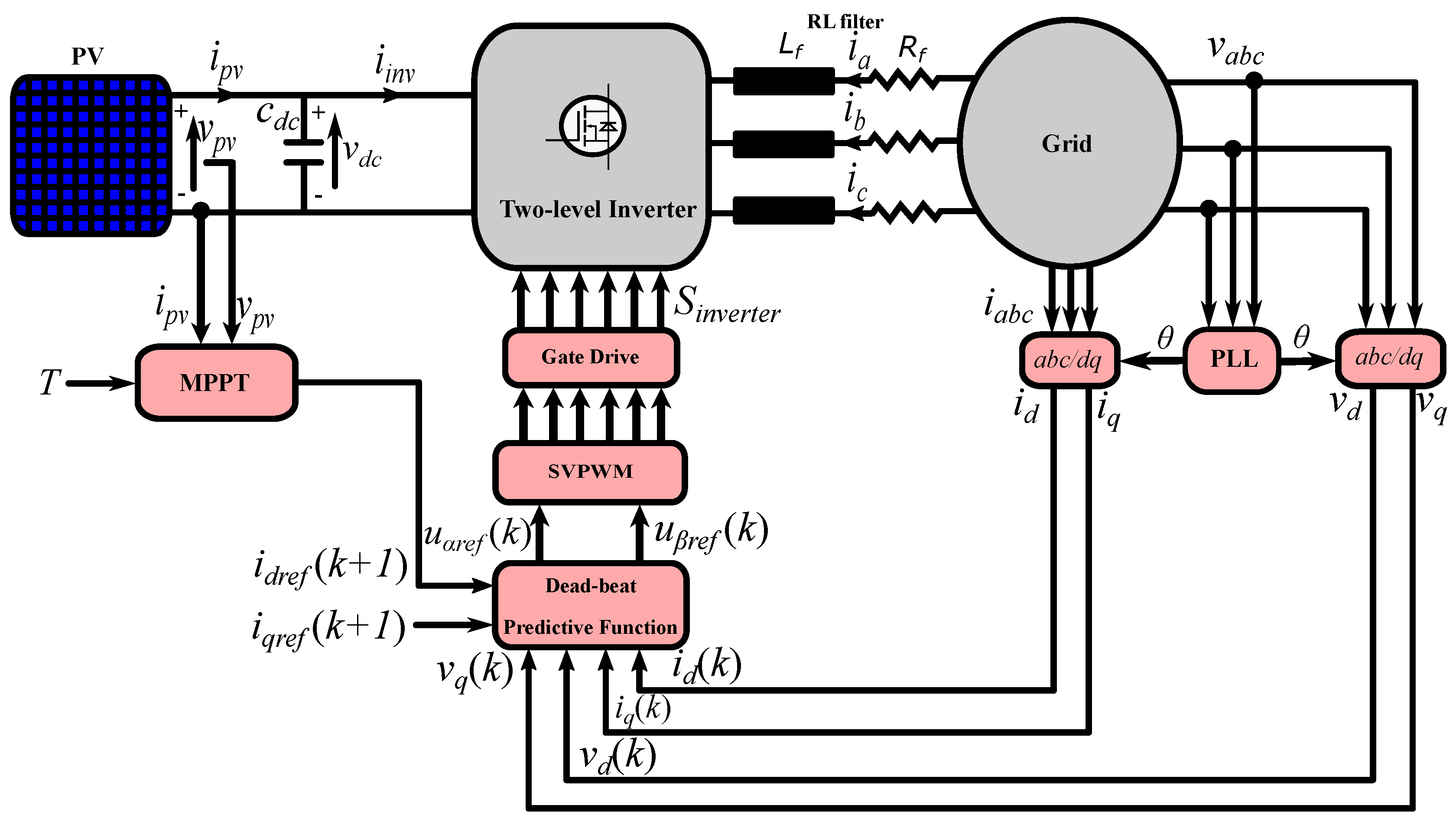
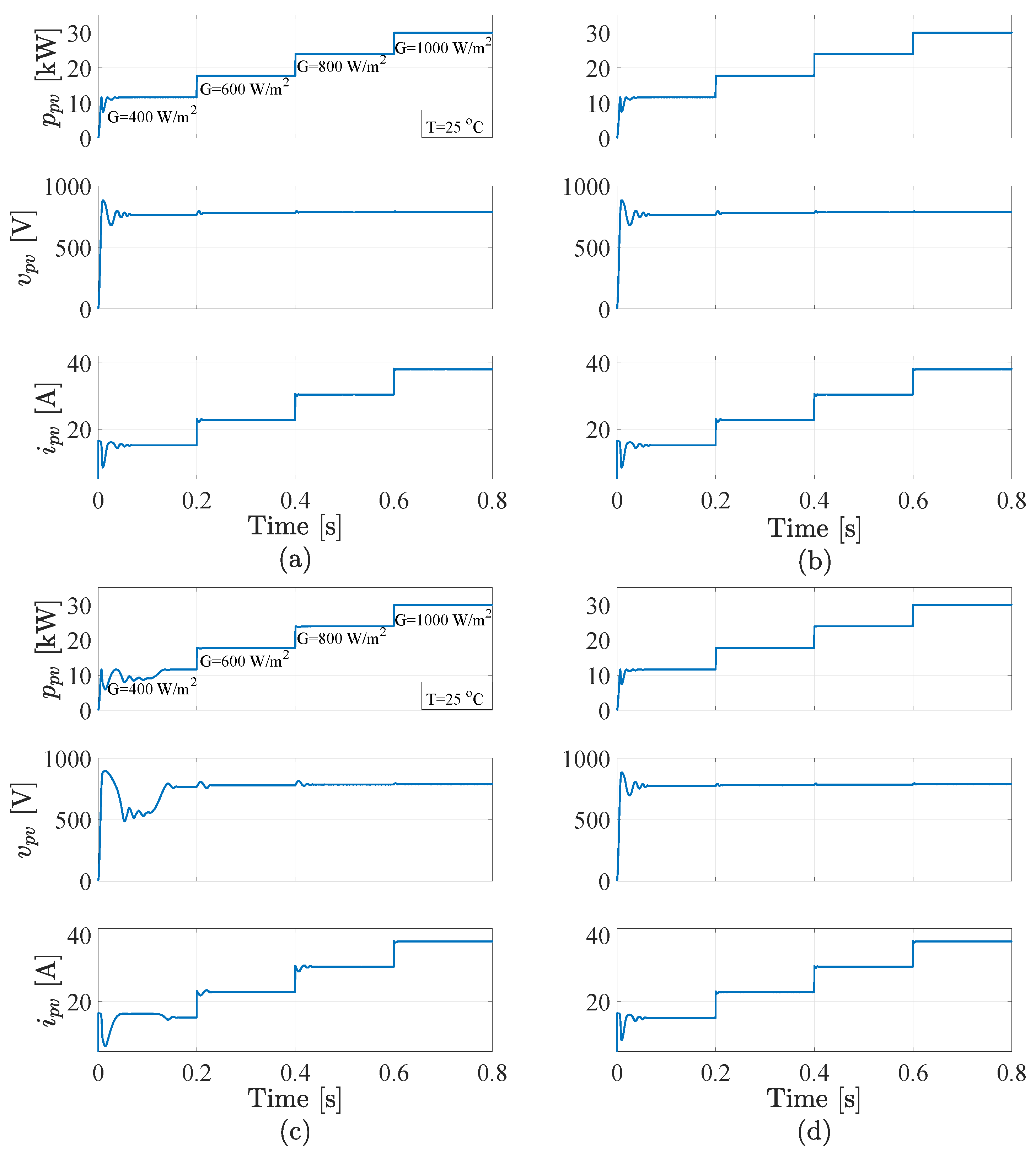


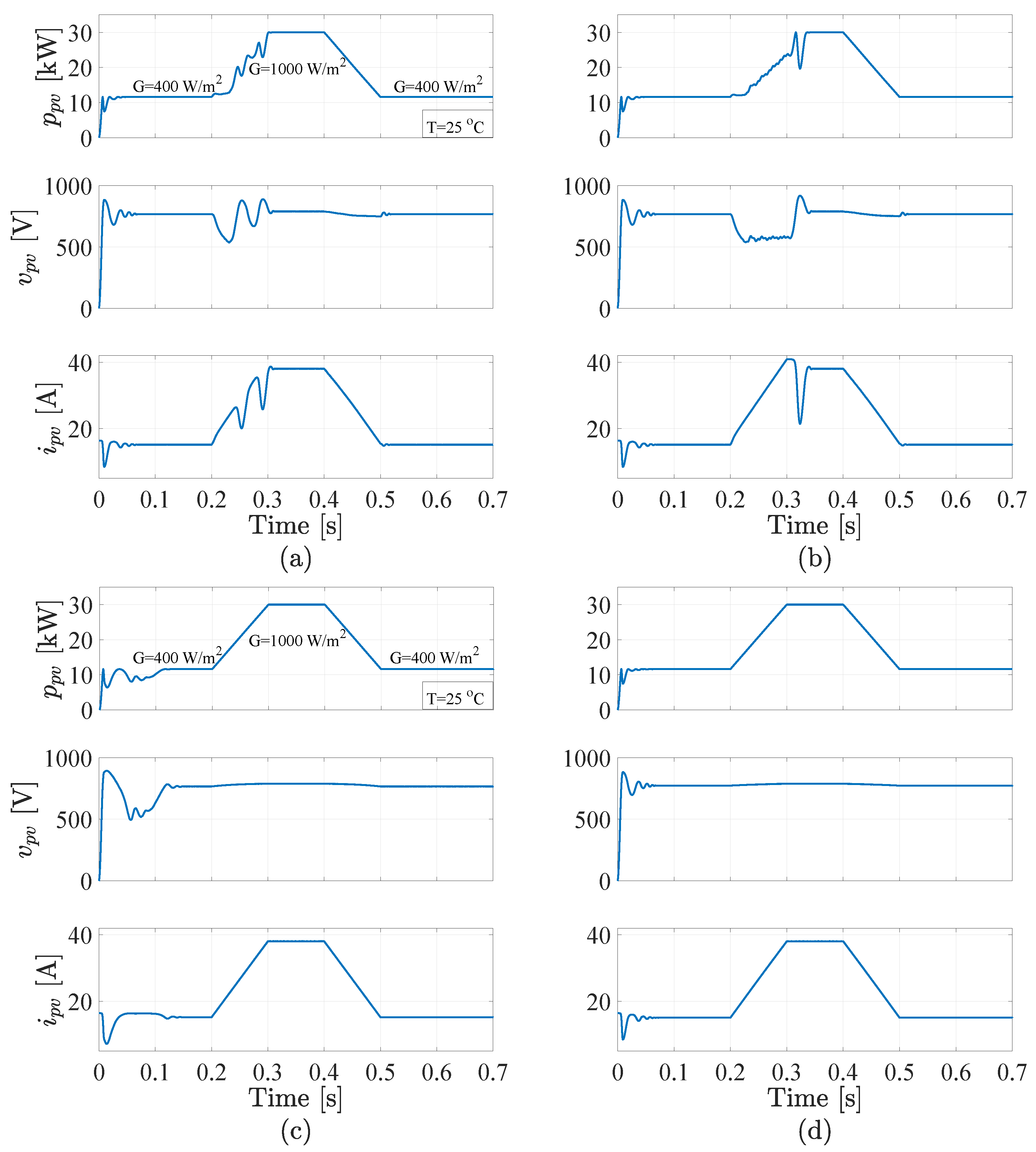

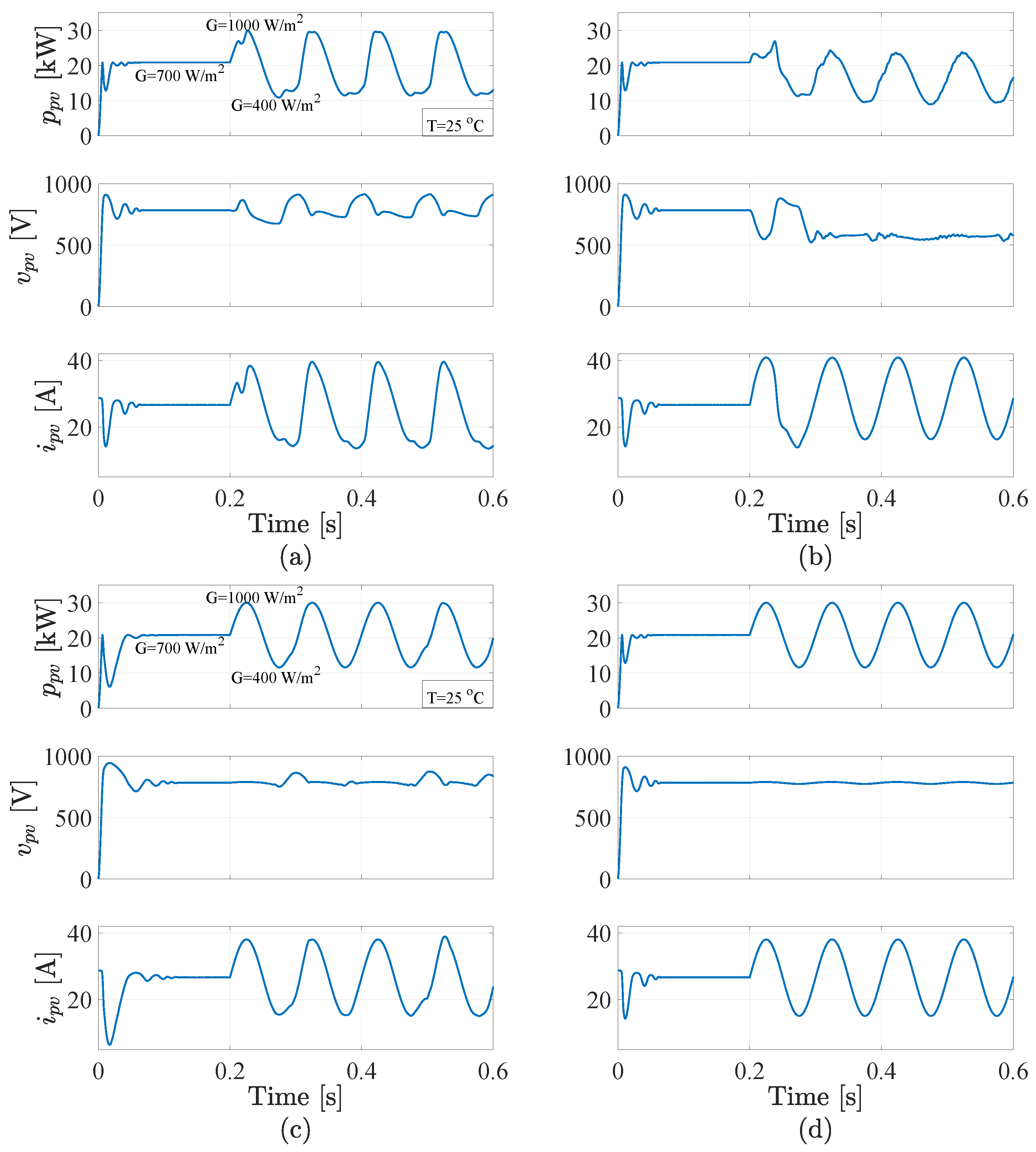
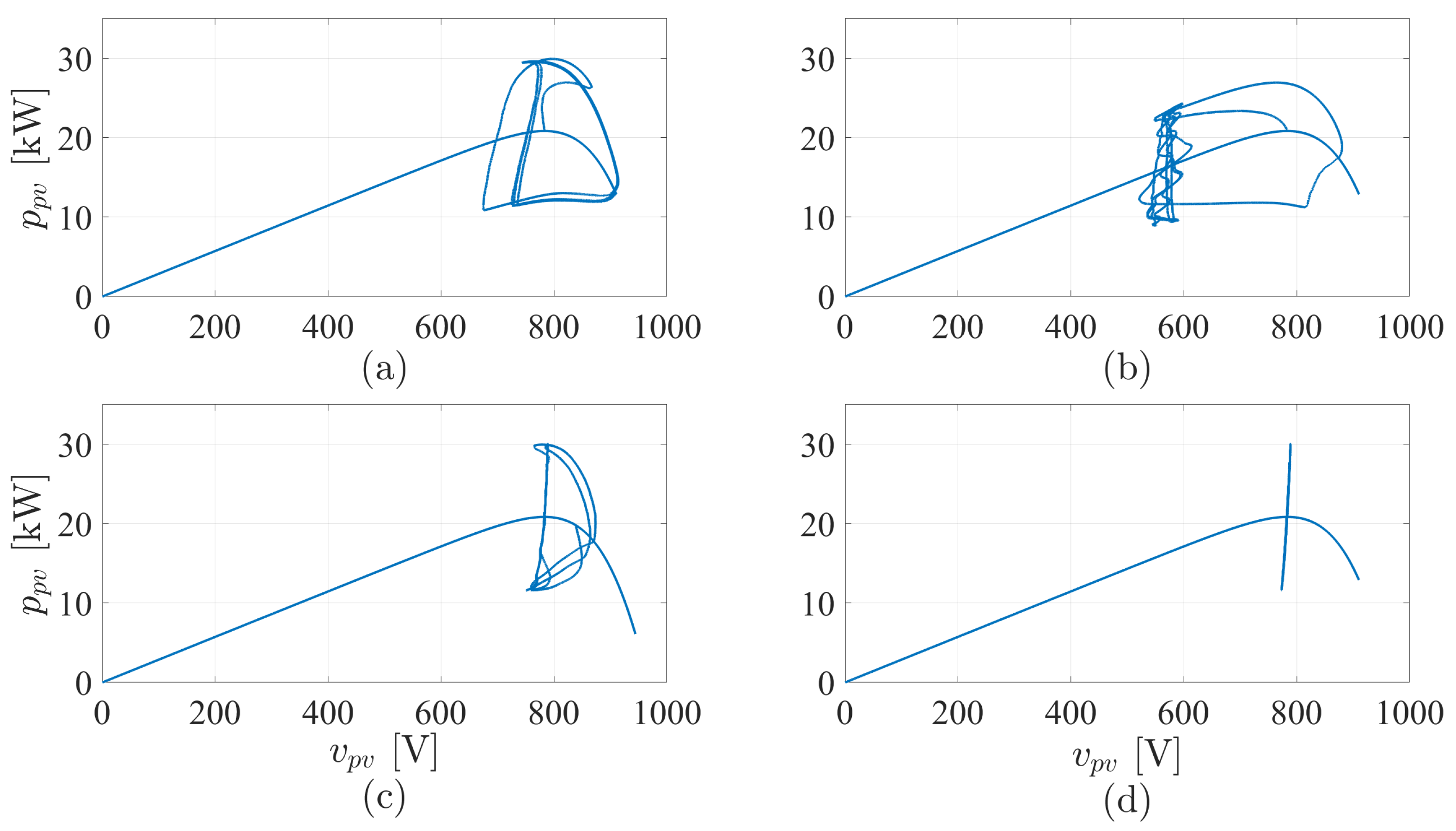

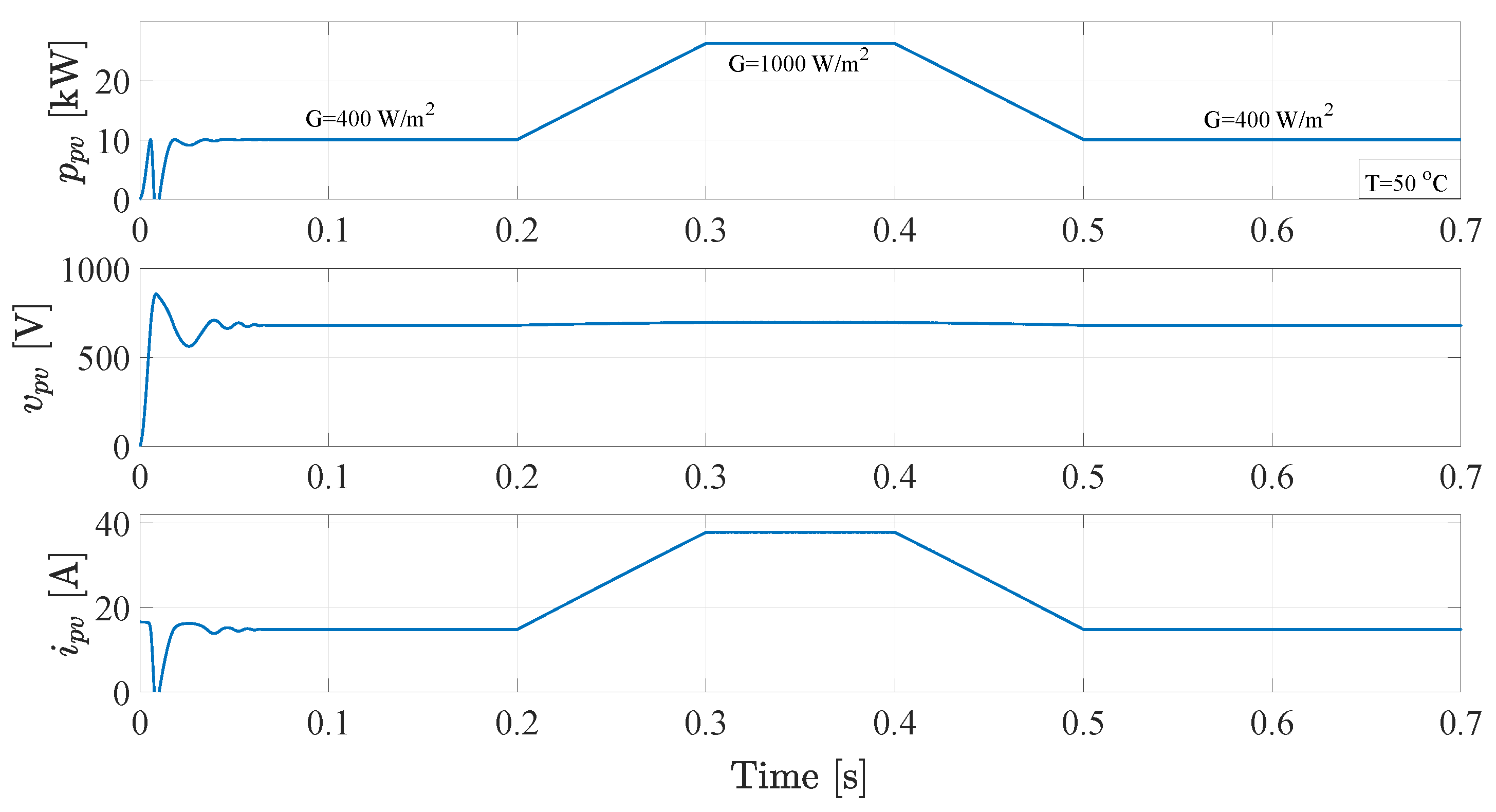
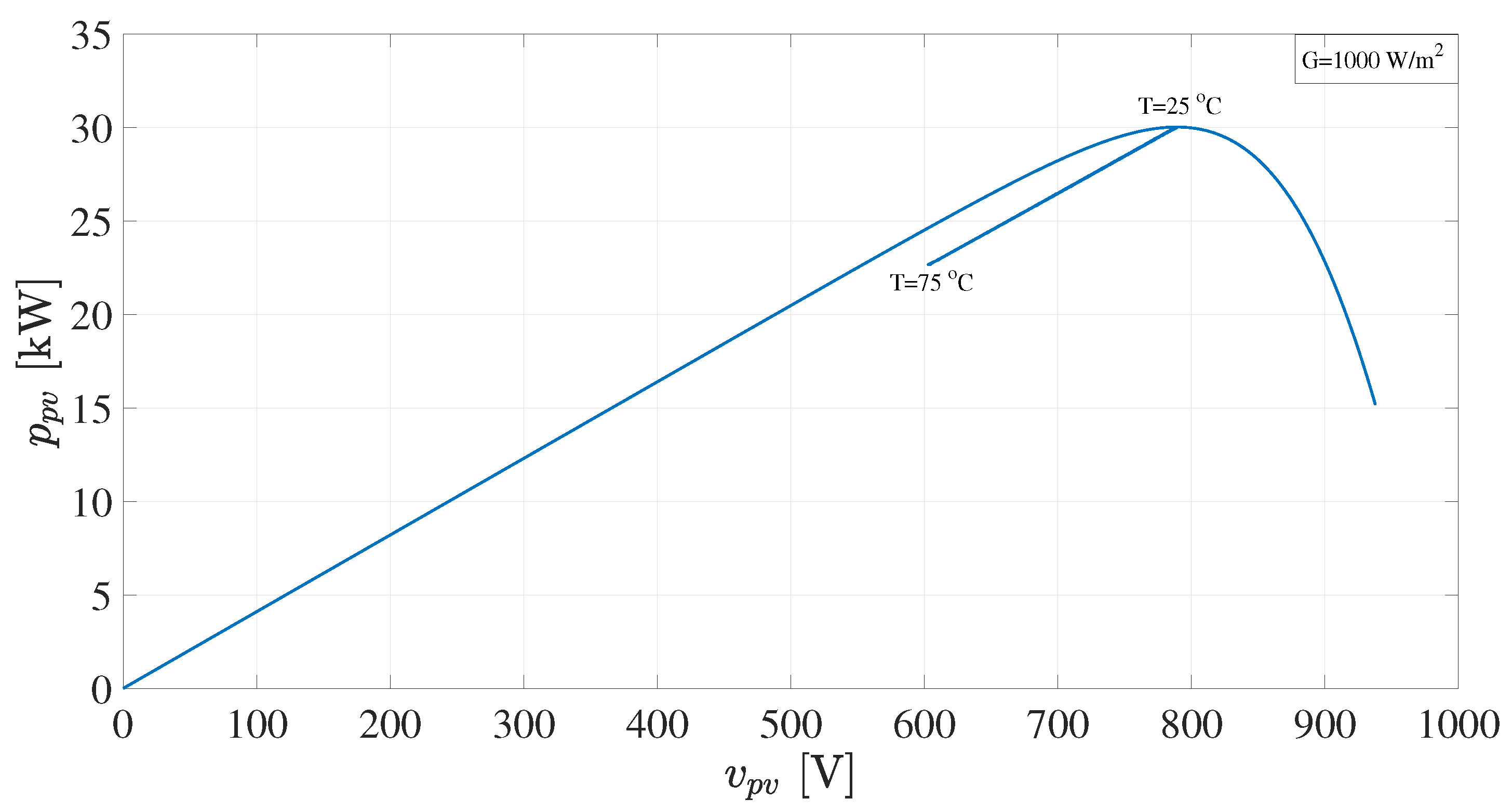

| Variable | Value |
|---|---|
| Array power level (kW) | 30 |
| DC-link capacitance () | 1000 |
| Switching frequency (kHz) | 10 |
| Filter’s inductance () | 5 |
| Filter’s resistance () | |
| Angular grid-frequency () | |
| Grid-voltage v () | 400 |
| Condition | THD | |||
|---|---|---|---|---|
| P&O | Mod. P&O | Multi-Power-Sample | Proposed | |
| m | 2.88% | 2.88% | 2.89% | 2.67% |
| m | 1.97% | 1.94% | 1.98% | 1.78% |
| m | 1.48% | 1.47% | 1.50% | 1.34% |
| 1000 W/m | 1.19% | 1.18% | 1.23% | 1.09% |
| Condition | THD |
|---|---|
| 5 () | 1.78% |
| 6.25 () | 1.27% |
| 3.75 () | 2.66% |
Publisher’s Note: MDPI stays neutral with regard to jurisdictional claims in published maps and institutional affiliations. |
© 2020 by the authors. Licensee MDPI, Basel, Switzerland. This article is an open access article distributed under the terms and conditions of the Creative Commons Attribution (CC BY) license (http://creativecommons.org/licenses/by/4.0/).
Share and Cite
Ahmed, M.; Abdelrahem, M.; Harbi, I.; Kennel, R. An Adaptive Model-Based MPPT Technique with Drift-Avoidance for Grid-Connected PV Systems. Energies 2020, 13, 6656. https://doi.org/10.3390/en13246656
Ahmed M, Abdelrahem M, Harbi I, Kennel R. An Adaptive Model-Based MPPT Technique with Drift-Avoidance for Grid-Connected PV Systems. Energies. 2020; 13(24):6656. https://doi.org/10.3390/en13246656
Chicago/Turabian StyleAhmed, Mostafa, Mohamed Abdelrahem, Ibrahim Harbi, and Ralph Kennel. 2020. "An Adaptive Model-Based MPPT Technique with Drift-Avoidance for Grid-Connected PV Systems" Energies 13, no. 24: 6656. https://doi.org/10.3390/en13246656







